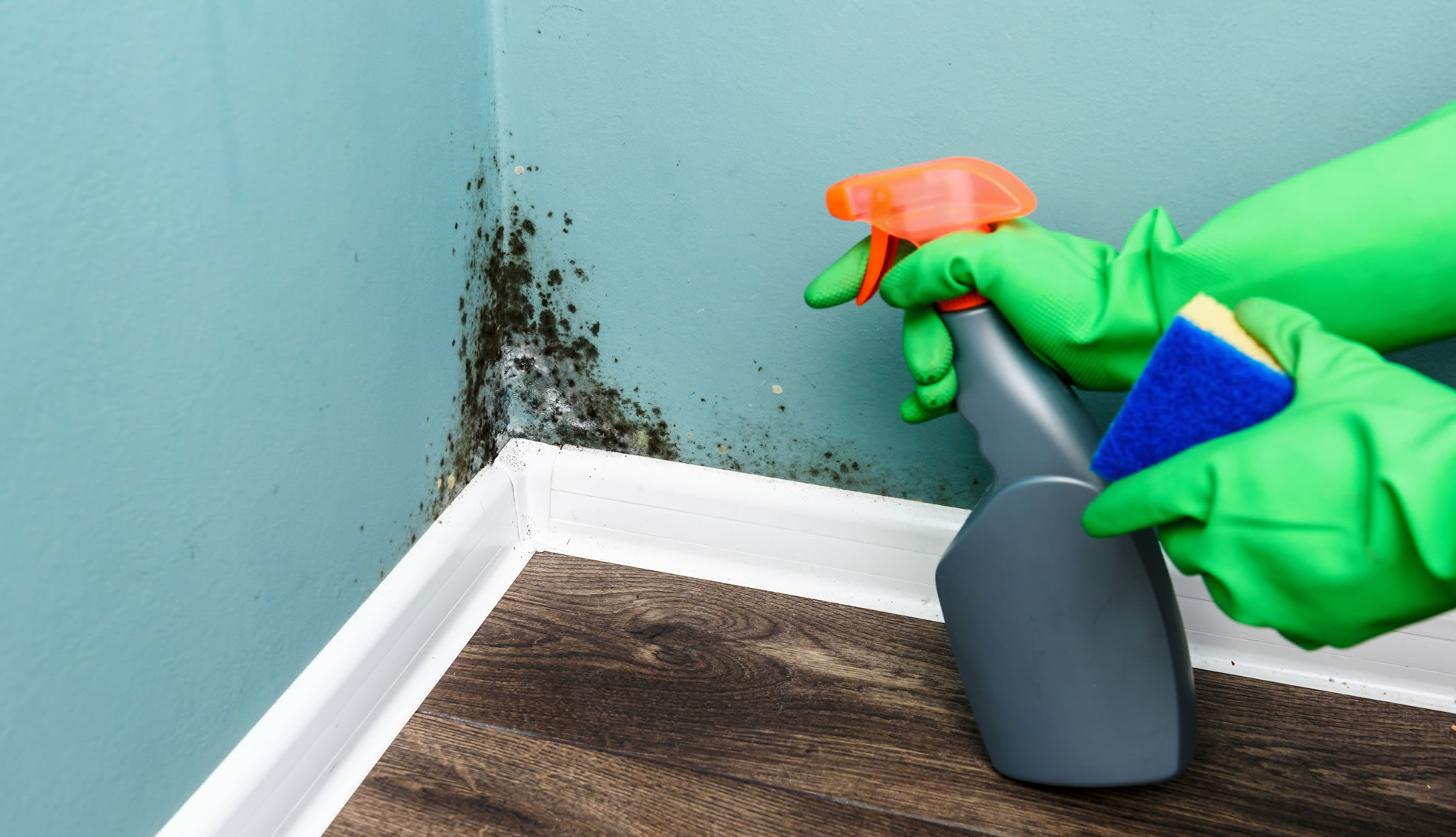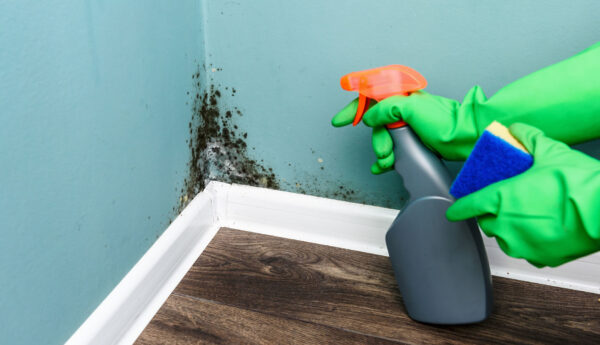It’s that time of year again, a time when tenants are most likely to complain about the mould appearing in those corners of the property where the walls and ceilings are really cold, and hot air with moisture always rises to the top. If it’s black mould at the top of walls, you can bet its condensation and not just damp.
As winter approaches outside temperatures drop and this perennial landlord’s problem of winter condensation and black mould rear their ugly heads yet again. I say yet again, because once the mould spores are there, they will keep reoccurring when the conditions are right.
The big question is, how do you know if this is caused by the building itself or the tenant’s lifestyle, or is it a combination of these two?
Dampness or condensation symptoms are very similar but the cures are very different, and to the uninitiated applying the wrong methods can be both expensive and ineffective.
When tenants start to complain about “damp” to their letting agents and landlords, you need to have some answers.
- What causes condensation?
- Is it the same as dampness?
- Why is it that some tenants have condensation problems, while others don’t, even in the same property?
- Why is it that the condensation problem is more prevalent in rented properties?
- Why are older properties affected more than modern ones?
- What effective measures can be taken to solve this problem?
- What can landlords do if they are taken to court over this or when rent arrears tenants claim in court they don’t pay because of dampness?
- How can landlords deal effectively with repair requests?
I’ve had many years dealing with these problems in residential as well as commercial properties and in that time I’ve begun to develop a really good understanding of this tricky problem and how to deal with it – in this article I will attempt to answer these questions and provide some solutions.
I can say from the outset, despite the many articles written on the subject, it’s not generally very well understood. There’s a lot of misunderstanding around it, and even some so called “experts” get it wrong.
Mention damp and black mould, and we’ve all seen those nasty pictures in print and in the television documentaries, the look horrific and immediately the landlord is denounced; he or she becomes the pariah figure who is condemning tenants to live in appalling health-threatening conditions.
Yes, it’s true that some properties have such serious defects that they are prone to damp and condensation and their owners need to put them right.
But far more common is a situation where the root-cause of the problem is the way the tenants are living, or sometimes it’s a combination of that and inadequacies with the property.
The problem landlords have is that tenants, the general public, environmental health officers (EHO), solicitors and judges in court, very often just don’t understand the difference between damp and condensation, their root causes, and who is really to blame.
What causes condensation?
Tenants often report dampness in a property when in fact the black mould on the walls and musty smells on clothes are caused by condensation.
Condensation occurs when warm moisture laden air meets a cold surface. Typical is when steamy air from cooking, washing and drying clothes rises up to the top of the house and meets a cold surface; easily visible as water droplets on window pains and tiles, but less so when the moisture meets cold wallpaper, plastered walls, carpets and clothes in wardrobes in unheated rooms. Then it is invisible, quickly absorbed into these materials and results in that cold musty smell and mould spores.
The result is a dank, cold house with musty smells and the tell-tale black mould, which can become toxic and injurious to health.
So, there are two main causes of condensation:
1 – Too much steam and moisture laden air that rises through the house rather than being vented outside at source; usually from the kitchen or bathroom, or typically when clothes are left to dry on radiators.
2 – A house with rooms that are far too cold.
Ventilation
When steam is produced it should be vented out of the house in the room where it is produced, by opening windows, using permanent vents or extractor fans, and closing doors to prevent it circulating round the house.
The problem is that opening windows in winter is not something people want to do as it cools the room and providing permanent air vents does the same thing. I’ve seen many vents purposely blocked with rags by occupants.
It does not help that the modern house, with all our draft proofing measures, unlike the old days with chimney ventilation, becomes a hermetically sealed box, so even new houses suffer some condensation. But condensation does not discriminate between new and old properties – if the conditions are right it will occur in both.
Rooms too Cold
It’s always the coldest rooms where condensation happens and black mould appears, usually tops of walls in bedrooms and bathrooms which receive the least heating.
Very often it’s simply a matter of not providing enough heat in the house, either to save money, because the occupants can’t afford to heat, or because the heating system is not adequate for the task.
Fluctuating temperatures don’t help: tenants tend to leave the heating off all day and blast with heat and steam when they return – ideal conditions for condensation.
When the house is poorly insulated, as in many older properties without cavity walls, heating is expensive because a lot of it is being wasted. Then, lack of heat leads to colder and colder moisture absorbing walls and more and more condensation. It’s a self-perpetuating circle.
A really well insulated and heated house will rarely suffer much condensation because everything including carpets, wallpaper and clothes in wardrobes are all nice and warm and will not absorb moisture, even when some steam is generated. No rooms should drop below 18 degrees C day or night.
Interstitial Condensation
A technical term used to describe what happens when condensation remains a problem for a long time. The cold walls absorb more and more moisture which penetrates deep into the walls; the wallpaper, plaster and masonry, and even timber, which will eventually lead to dry rot. The moisture is so deep it will take months to dry the building out, even when more than adequate heating is applied.
Likewise mould spores will develop on surfaces which eventually become toxic (causing a real health hazard) and are then extremely hard to eradicate.
So, once these conditions have been allowed to develop they can be very difficult to reverse; they do a lot of damage to the fabric of the building. After a while plaster just disintegrates and crumbles away. These conditions are also a serious health issue for anyone attempting to clean up – special precautions are required.
Dampness
Dampness is different to condensation and has different causes which are invariably defects in the building and most definitely a landlord issue. These are not difficult to spot and eliminate: a leaking roof, rising damp in the lower parts of ground floor walls and floors in basements, or a leaking water pipe. All these will create a localised problem and will appear different to condensation and mould.
Older properties and insulation
Many rental properties fall into the older category and are without cavity walls and modern insulation standards. In fact it has been estimated that around 16% of UK rental property stock does not meet modern Decent Home standards. The Energy Performance Certificate (EPC) gives an indication of this when a tenant enters into a tenancy.
Coming up soon is an important repair issue for landlords, which although EU inspired, it is thought unlikely that Brexit will have any effect on the introduction of the Minimum Energy Efficiency Standards (MEES ) regulations. These will make it unlawful from April 2018 to let buildings (both commercial and domestic) in England and Wales which do not achieve a minimum Energy Performance Certificate (EPC) rating of ‘E’.
As poor energy performance is not limited to old or obsolete buildings, MEES will have significant impacts for a number of landlords, tenants, and property agents. Landlords should really be thinking about this, planning for and taking action now to avoid higher costs and protecting their revenues from their properties.
The MEES regulations apply in England and Wales. There are different but complimentary regulations applying in Scotland, which have been developed under Section 63 of the Climate Change (Scotland) Act, known as ‘Action on Carbon and Energy Performance’ (ACEP).
This means that one in ten buy-to-let homes could be unlettable in less than two years’ time unless their landlords take steps to improve their property’s energy efficiency.
Tenants are also able to demand improvements to insulation from April 2016, when landlords will not be able to refuse tenants’ “reasonable” requests for energy efficiency measures, but it this case the tenant would be obliged to pay for the improvement.
The legislation states that landlords must not let out properties with the two lowest energy efficiency ratings, F and G, after April 2018 at the latest. According to a recent English Housing Survey, 11.4pc of homes in the private rented sector were rated F or G in 2011.
Damp specialists
Beware the damp specialists who come into a condensation riddled property with their two-pronged meter, showing you just how much dampness the wall contains. Of course it does, because the condensation has well and truly soaked in over time, but their suggested remedies will often be very expensive and ineffective.
Advice for your tenants:
The incidence of condensation can be reduced by:
- Leaving background heating on all day in all rooms and generally making sure the house is adequately heated in cold weather. Insufficient heating is the main cause of condensation in rental properties.
- Opening a window or using cooker and wall extractor fans when cooking and keeping lids on saucepans.
- Leaving bathroom doors closed and the windows open after a bath or shower to clear steam.
- Keeping the bathroom door closed when washing, having a bath or shower.
- Never blocking air vents or airbricks.
- Opening windows in all your rooms for a short period each day to allow some fresh air to circulate.
- Never drying clothes on radiators or storage heaters with damp clothing.
- Never introducing portable LPG heaters – they produce 1.6 litres of water for every kg of gas burned.
Advice for landlords
- Make sure the property is free from issues that can cause dampness – leaking roofs, gutters, downpipes, rising damp, bridged damp courses, leaking pipes, blocked drains etc.
- Make sure the property meets modern insulation standards – you will need to bring your property up to standard before 2018, so you may as well do it sooner rather than later and avoid problems with condensation.
- Make sure the heating system is adequate for the property and is well maintained.
- Consider fitting extractor fans in kitchens and bathrooms and trickle vents in window frames. These extractors can be of the automatic types which operate when humidity levels rise, but remember, people will often block these up if they feel the cold.
- In extreme cases think about supplying a dehumidifier which will remove moisture and dry out rooms.
- Beware when cleaning black mould as the pours can be toxic and a major health hazard – seek professional advice from cleaning specialist with the right equipment.
- The ultimate cure is a full house loft mounted air recirculation system with heat exchangers which provides a continuous flow of fresh, warm dry air throughout the building. There are some well established companies supplying this equipment.







